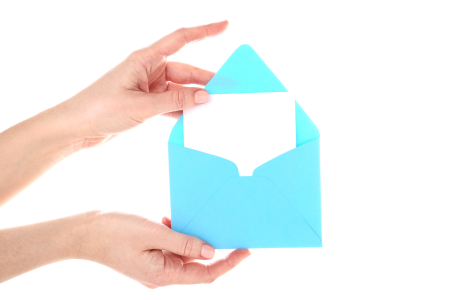Make them clear, easy to understand
What makes one email campaign generate an amazing 93% open rate, while another languishes at a dismal 0.5%?

Ask the researchers at MailChimp, an email service provider. They analyzed open rates for more than 200 million emails.
Make emails “short, descriptive and provide the reader with a reason to explore your message further.”
— MailChimp
“The best email subject lines are short, descriptive and provide the reader with a reason to explore your message further,” write the researchers. “Splashy or cheesy phrases more often cause your email to be ignored rather than make them stand out.”
Top 5 subject lines by open rates |
||
Subject line |
Open rate |
Why? |
| Preliminary Floor Plans for Southern Village Neighborhood Circle Members | 93% | Timely information; implied benefit for quick action; longer than 50 characters |
| Your April Website Stats | 92.6% | Timely, useful information |
| Idlewild Camp – Important Travel Information | 90.1% | Information I need now |
| Invitation for Murdoch, Brown, Rove & Johnson’s Snow Ball | 89.7 | Personal, timely |
| MotorCycling Magazine Reader Survey | 88.1% | High affinity to activity/experience |
A peek inside MailChimp’s top 5 subject lines all clearly state what’s inside the message.
What do recipients really want?
Subject lines help the folks on your email list decide whether the juice is worth the squeeze — or the e-zine is worth the open. To increase your open rates, write good email subject lines that:
1. Tell, don’t tease.
Don’t make your subject line a teaser to get recipients to open the message. Instead, make your subject lines clear, like these, suggest the folks at the Nielsen Norman Group:
dyad: Dictionary.com Word of the Day
— Word of the Day
Term Loans — Rates as low as 5.5%
— Commerce Bank
NFL Postseason Ticket On-Sale Information
— Kansas City Chiefs
“It might be tempting to think that a generic subject line will entice users to open a message to see its content. After all, if users can see the content in the subject line and determine they’re not interested, they won’t open the message,” writes Janelle Estes, senior user experience specialist at the Nielsen Norman Group.
“It’s much better to inform the user and let them decide than to require them to open a message to find out that they’re not interested in it. Many people may not bother at all and simply delete it instead.”
2. Consider your subject line a promise, and keep it.
If your subject line is Get to know Karelyn Lambert, then your content better not be “shop her favorites” with a link to all of your products. (Maybe make that a call to action or next steps, instead.)
3. Don’t over-deliver.
If you promise targeted content, recipients expect focused, simple content — not sprawling lists of everything including the kitchen sink.
“Users expected the payoff to be high when they clicked to view any email,” write Kim Flaherty, Amy Schade, and Jakob Nielsen of the Nielsen Norman Group.
“They were satisfied when their expectations were sufficiently met with content that delivered on the promise that the subject line made. However, they were increasingly frustrated when content was only loosely related, or forced them to go to the site to get the information advertised in the subject line with many users stating that they felt mislead by the email.”
And when that happens, your emails are likely to wind up in recipients spam folders.
Avoid generic email newsletter subject lines.
Generic subject lines — “Newsletter name” — are more likely to be deleted than opened. So says usability guru Jakob Nielsen. So says MailChimp.
Why avoid generic subject lines? Repeating subject lines:
1. Reduces email open rates.
“It’s obvious that if you send the same campaign over and over again (such as reminders for an event), your open rates will decline with each subsequent campaign,” write the experts at MailChimp.
How much should you expect it to decline? In one study, MailChimp tracked the results of these similar event reminders:
- 1st email: Funk n Sandi @ The Roxy on 3 March — 8% open rate
- 2nd: Funk ‘n’ Sandi @ The Roxy on 3 March — 6.3%
- 3rd: This Sat 3 Feb — Funk n Sandi @ The Roxy — 5.1%
- 4th: Don’t forget — Funk ‘n’ Sandi this Sat 3 Mar!— 3.5%
2. Makes your message hard to store.
I save my e-zines for reading on planes. I’ll bet you save yours for a more convenient time, too.
The problem with generic subject lines is that they’re hard to store. When I save one with a generic subject line to my “reads” file, I have to rewrite the subject line:
- Instapaper
- Instapaper-2
- Instapaper-3
- Instapaper-4
- Instapaper-5
3. Makes your message hard to find.
Oh, my God! An article in one of your e-zines has changed my life. I want to be able to refer to it often and share it with everyone I know.
But where is it? Will I find it in:
- HubSpot Blog, Opinion
- HubSpot Blog, Opinion-2
- HubSpot Blog, Opinion-3
- HubSpot Blog, Opinion-4
- HubSpot Blog, Opinion-5
How to write specific subject lines
So how can you make your subject lines less generic?
1. Tell the story.
For years, the folks at Daily Puppy sent out this subject line … every … day:
The DailyPuppy | Pictures of Puppies
I like pictures of puppies as much as the next gal, but I’m not sure I’d open that after, say, the 100th day. But Daily Puppy recently changed its subject lines to include the puppy’s name and breed. Who wouldn’t want to:
Meet Pistachio the English Bulldog!
Don’t write e-zine subject lines like this:
April news from Litmus
New Post is up on That’s Not My Age
What’s new in MailChimp: April 2018
Instead, treat your subject lines as headlines. Summarize your lead article in subject lines like these:
5 Types of E-Commerce Shoppers
— Nielsen Norman Group
Police officer’s good deed draws praise on Facebook
— SmartBrief on Social Business
The Interpreter: How America came to love small wars
— The New York Times
Voter registration + turnout = historic midterm election
— Indivisible
Starbucks will close 8,000 locations for racial bias training
— Eater
2. Don’t repeat the sender in the subject line.
They’ve already seen your From line. Avoid wasting any of your 25-40 characters repeating that information.
Instead of …
Alan Weiss | Unique development from Alan Weiss
… how about delivering some details about the development?
Alan Weiss | Multiply your income with new classes
Instead of …
SEO Tips List | [SEO-Tips] Tomorrow’s SEMRush Meetup
… how about delivering some details about the development?
SEO Tips List | Save $50 on tomorrow’s SEMRush Meetup
3. Drop the date.
Most email clients display this information near the subject line. (Not that recipients are scanning your subject line for calendar information.)
Plus: Don’t let dreary details like dates get in the way of the information that actually drives opens: the contents of your e-zine or newsletter.
Overcome sender unfamiliarity.
While generic subject lines don’t get clicked, enticing ones drew them into the email — even when they weren’t familiar with the senders. (And overcoming sender unfamiliarity isn’t easy.)
“When users are looking through their inboxes and dealing with vast amounts of email, any indication that a message is worth opening is helpful,” Nielsen writes.
Like this one, from Roger Dooley:
Simple Hacks to Develop a Magnetic Memory, more
Want to get opened? Before sending an email, make sure your subject line is clear and easy to understand — and change them up.
Learn more
- How to add a sense of urgency to email subject lines
- How to write a recognizable ‘from’ (email address) line
- Don’t be afraid to use questions in subject lines. But skip exclamation points.
- Tips for writing effective social media, blog posts, content marketing pieces
- Learn to get read on mobile devices.
___
Sources: “Best Practices for Email Subject Lines,” MailChimp, June 20, 2018
Janelle Estes, “Email Subject Lines: 5 Tips to Attract Readers,” Nielsen Norman Group, May 4, 2014
Kim Flaherty, Amy Schade, and Jakob Nielsen; Marketing Email and Newsletter Design to Increase Conversion and Loyalty, 6th Edition; Nielsen Norman Group, 2017

Leave a Reply